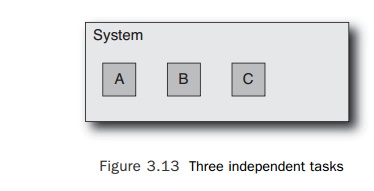Chapter: Multicore Application Programming For Windows, Linux, and Oracle Solaris : Identifying Opportunities for Parallelism
Multiple Independent Tasks
Multiple
Independent Tasks
As
discussed earlier in the chapter, the easiest way of utilizing a CMT system is
to perform many independent tasks. In this case, the limit to the number of
independent tasks is determined by resources that are external to those tasks.
A web server might require a large memory footprint for caching recently used
web pages in memory. A database server might require large amounts of disk I/O.
These requirements would place load on the system and on the operating system,
but there would be no synchronization con-straints between the applications
running on the system.
A system
running multiple tasks could be represented as a single system running three
independent tasks, A, B, and C, as shown in Figure 3.13.

An
example of this kind of usage would be consolidation of multiple machines down
to a single machine. This consolidation might just be running the web server,
e-mail server, and so on, on the same machine or might involve some form of
virtualization where different tasks are isolated from each other.
This
approach is very common but not terribly interesting from a parallelization
strat-egy since there is no communication between the components. Such an
approach would increase the utilization of the machine and could result in
space or power savings but should not be expected to lead to a performance
change (except that which is attained from the intrinsic differences in system
performance).
One place
where this strategy is common is in cluster, grid, or cloud computing. Each
individual node (that is, system) in the cloud might be running a
different task, and the tasks are independent. If a task fails (or a node fails
while completing a task), the task can be retried on a different node. The
performance of the cloud is the aggregate throughput of all the nodes.
What is
interesting about this strategy is that because the tasks are independent,
per-formance (measured as throughput) should increase nearly linearly with the
number of available threads.
Related Topics